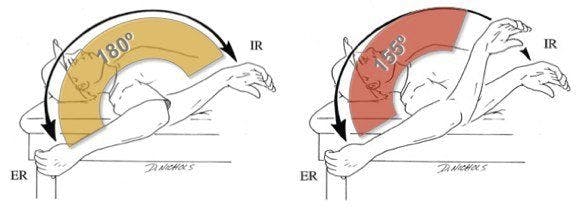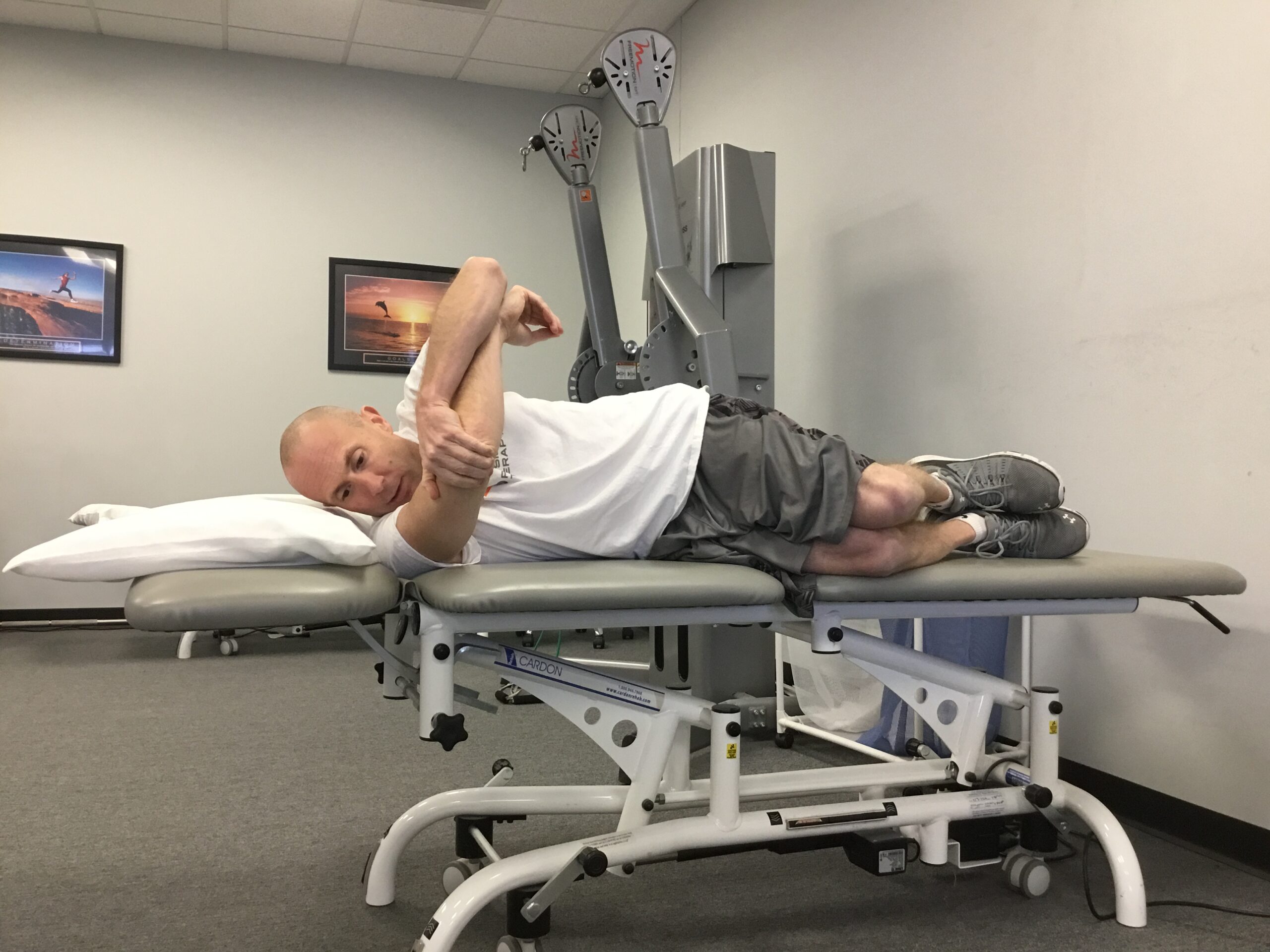The unique demand of throwing a baseball places tremendous stress on your arm bones, muscles, and soft tissues. Therefore, shoulder and elbow injuries are common among baseball players of all ages. Repetitive throwing leads to normal changes in your bones and muscles around your shoulder. Some of these changes are necessary to perform at a high level. Other changes, specifically those related to muscle tightness, can increase your risk of sustaining an elbow or shoulder injury. Therefore, it is important for baseball players, coaches, and parents to understand the rationale and best methods for doing arm care stretches.
Range of Motion in the Baseball Pitcher
Repetitive throwing during a young player’s period of peak growth causes changes to the structure of the upper arm bone. The middle portion of the arm bone rotates backward about the upper end of the bone. This is termed retroversion, and it is a necessary and beneficial adaptation. It allows the baseball player to achieve greater amounts of shoulder external rotation range of motion, or layback, during the arm cocking phase of throwing.
Retroversion causes an increase in the amount of shoulder external rotation but a decrease in the amount of available internal rotation. Again, this is a necessary change to improve performance. Research suggests that the total arc of internal and external rotation range of motion is what becomes important. The total arc of motion between the throwing and non-throwing shoulder should be within 5 degrees of each other (shown in the illustration below). Stretching exercises help restore symmetry between sides when differences are large.

The Basics of Arm Care Stretching
Baseball players lose range of motion throughout a single game and a season. This loss of flexibility occurs in the shoulder and elbow muscles. Common muscles prone to tightness in baseball players are the rotator cuff, lats, pecs, biceps, and triceps. A regular stretching routine, performed 3-5 times per week, helps restore lost range of motion. Also, a basic 10-minute stretching routine may improve performance and decrease your risk of an arm injury. The stretching exercises presented here are a few that baseball players should be familiar with.
5 Arm Care Stretching Exercises for Baseball Players
Cross-Body Stretch
This stretch addresses the shoulder muscles that are prone to tightness in overhead athletes. The infraspinatus, teres major, and teres minor muscles become shortened from repetitive throwing. To do this stretch, lie down on your involved side with your hips and knees bent. Position your involved shoulder and elbow at a right angle. Next, grasp your elbow and gently pull it across your body. Hold the stretch for 30 seconds. Perform this stretch 2-3 times each session.
Sleeper Stretch
The cross-body stretch is better than the sleeper stretch for improving shoulder range of motion in young baseball players. However, the sleeper stretch is the more popular one. For this stretch, lie down in the same starting position as the cross-body stretch. However, with the sleeper stretch, your wrist and forearm are gently moved down towards the table. Once a mild stretch is felt on the outside or back of your shoulder, hold for 30 seconds. Do this stretch 2-3 times each session. Both the sleeper and the cross-body stretch do not need to be performed. My personal experience and the best available evidence suggest the cross-body stretch is the most beneficial of the two.
Bench T-Spine Mobilization
Extension of the upper back is necessary to achieve the arm cocking position during throwing. Without adequate extension, unnecessary stress will be placed on your shoulder or elbow. This exercise also provides a nice stretch to the latissimus dorsi and triceps muscles. These muscles, when tight, limit overhead mobility.
Start by assuming a kneeling position facing a bench. Place your elbows on the bench in front of you, holding a PVC pipe or dowel with your palms facing up. Sit back, push your buttocks towards your heels, and keep your spine relaxed, until you feel a stretch in your upper back. Engage your abdominal muscles to prevent excessive arching of your lower back. For an added stretch, you can bend your elbows further past your head. Hold this position briefly, and exhale fully. Do 6-10 repetitions.
Thoracic Spine Windmill
This is a great dynamic mobility drill to restore thoracic spine rotation and improve the flexibility of your latissimus and pectoral muscles.
Begin on your side with both arms outstretched in front of you. Place a foam roll under your top leg with your knee and hip bent to 90 degrees. Your bottom knee and hip remain extended throughout the exercise. Reach forward with your top hand and then complete a large circular windmill motion with your entire upper body. Follow your hand with your eyes to ensure good thoracic spine and rib cage movement. Your top knee and leg should remain in contact with the foam roll. Perform 6-8 repetitions on each side.
Side-Lying IR/ER
This is a more advanced dynamic mobility exercise targeting the thoracic spine, rib cage, latissimus dorsi, and pectoral muscles.
Start in a side-lying position. Place a foam roll under your top leg with your knee and hip bent to 90 degrees. Your bottom knee and hip remain extended. Initiate the movement by reaching with the lower arm up towards the sky. Hold this position, reaching upwards, throughout the drill. Your arm to be stretched is then placed overhead with the thumb pointing down towards the floor. Exhale fully at the top and then reverse the movement by bringing the arm down to your side. As the arm is lowered, the thumb position changes so it is pointing down towards your back pocket.
Both elbows must remain fully straight during the drill. We generally perform 6-8 repetitions on each side.
Get Help with the Right Arm Care Stretching Exercises
These 5 arm care stretching and mobility drills address typical muscle flexibility problems in baseball players. As always, an individualized approach is always superior to a ready-made one-size-fits-all program. Also, remember that arm strength is more important than mobility. Building arm strength through resistance training is the most important thing that will improve performance and resiliency in the baseball player.
Before engaging in any exercise program, those with a history of arm problems or those currently experiencing pain should first be evaluated by a physician, physical therapist, or athletic trainer. Some players may require additional arm care strategies such as passive stretching and soft tissue mobilization techniques. Give us a call if you would like more help.

